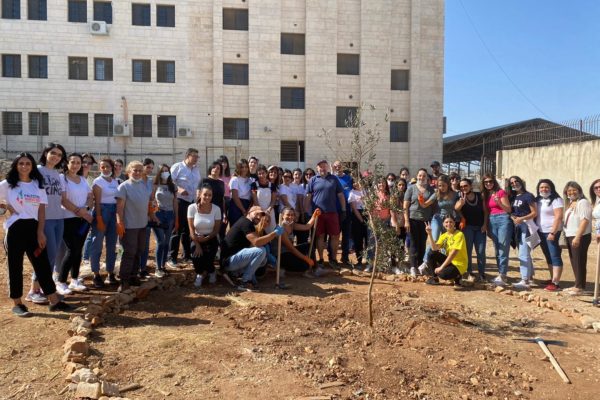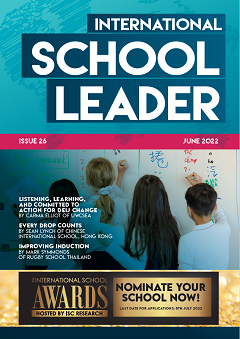By Andrew Watson
The Jerusalem American School (JAS) is a K-12 1000-student international school in Palestinian East Jerusalem. As the pandemic hit in 2020, JAS had lapsed into organisational dormancy. Ultimately accountable to the Israeli Ministry of Education (MOE), whilst simultaneously recognised as an international school by the Palestinian MOE, it had become a school of low aspiration and confused identity, characterised by endemic violence, outdated pedagogy and low morale.
A whole school focus on the UN Sustainable Development Goals (SDGs) helped to both resuscitate and bring hope to a school community and allowed its students to understand themselves anew, as authors of their own destinies, as Andrew Watson explains.
It is one thing to start a new school from scratch; quite another to discover one with 1,000 students and 100 staff in urgent need of a new beginning.
In 2020, I was invited to become Director of JAS, a K-12 co-educational 1,000 student international school in Beit Hanina, East Jerusalem. The school is recognised by the MOEs in both Israel and Palestine and straddles the political divide. Culturally, socially and economically, however, JAS is proudly Palestinian and had some jacha (kudos) attached to it. Local staff clearly cared deeply about their school, although knowledge and experience of international education (as the Council of International Schools and the International Baccalaureate understand it) was negligible.
The cavernous JAS buildings were neither built nor fit for purpose. As Nespor (2004) identified, education systems have both spatial and temporal dimensions; Bergsagel et al (2007) discuss the relationship between architectural place and school culture. An imposing wall around the campus, lined with unflattering graffiti, topped by spikes and railings, was complemented by bars on the windows. There were more bars at all four interior levels, contributing to a sense of penitentiary rather than pedagogy. Mountains of trash inside and outside the campus deepened the sense of neglect. Student and teacher behaviour largely reflected their immediate surroundings (Massey, 1994). Teachers felt undervalued, unheard and undermined. The first days of school revealed a habitual level of direct and gender-based violence among students.
Several interconnected ‘tectonic plates’ underpinned JAS. Governance, campus ownership, didactic pedagogy, the parent body, student life, faculty, health and safety, vision and moral purpose, were all dangerously disconnected. The school had become an archipelago of anomic apathy. Interconnected challenges necessitated interconnected responses.
Reimagining a new future
‘Start with why’ (Sinek, 2011). The first step of renewal was to reimagine a school fit for purpose for the 21st century. Societies function on the basis of a shared vision (Devlin in Sacks, 2020). A new mission and educational goal added sustainability to JAS’s commitment that ‘peace begins with me’. A revised educational goal recognised student agency, speaking of students becoming ‘authors of their own destinies’. Herein was a connection between the cultural and linguistic concept of maktub (it is written) and the idea that “schools have a choice, whether to be the mirrors of the society, or the change agents of it” (Sutherland, 1996). Enter the SDGs, the result of focused collaboration by experts from interconnected sectors around the globe; a pinnacle of human hope.
SDGs became the drivers of change and the reference points for how decisions should be made. Broadly speaking, the structure of transformation was inspired by Kouzes and Pozner’s leadership challenge, “modelling the way, inspiring a shared vision, challenging the process, empowering others and encouraging the heart” (Kouzes and Pozner, 1987). This is what the school needed; a connected systems thinking approach which allowed the ‘tectonic plates’ of the school to shift in unison rather than in perpetual tension.
“SDGs became the drivers of change and the reference points for how decisions should be made.”
Agents for change
For the first time, teachers elected representatives from the three sections of the school. When students came back to school, they (also the first time) elected their own leaders. Transforming the parent body into a Parent Support Group took slightly longer but, ultimately, all members of the school community felt valued, heard and empowered, enabling the school to start moving with a sense of shared purpose. The school community was arriving at the “threshold of their own minds” (Gibran, 1923). Change was coming from within.
Despite COVID-19, the latest Gaza conflict and Israeli/Palestinian tensions, the vocabulary of sustainability had found fertile ground. Relevant training for all staff followed, the first of its kind they had experienced. JAS teachers, students and parents attended two relevant, meaningful and action-oriented Sustainability Education (SusEd) webinar series – Case Studies for Change and Shifting Minds – which brought the JAS community into contact with the world. Continuity in purpose was provided by a team of United World College interns from Palestine who understood the context of East Jerusalem and the nature of the sustainability challenge. Training in Arabic in IB Approaches to Teaching and Learning helped teachers make sense of their new focus. Initial ambitions were modest and achievable. Implementing consistency across systems was strategically planned, incremental, achievable and communicated. Shifting the culture of the school embraced both the extrinsic and the intrinsic.
Reciprocal and sustainable partnerships were being built with other schools and organisations in and around Palestine, Israel and beyond. Students were actively engaged in decision-making. Concepts of Restorative Justice were being brought into conversations about anti-social behaviour and violence. Three sustainability coordinators – one for each section of the school – were appointed. One of their first tasks was to create a ‘sustainability week’ in January of the first year. This revealed hidden talent in the maintenance department, who, following a session on the “circular economy” and “doughnut economics” (Raworth 2012) collected and repurposed industrial palettes from the local supermarket and transformed them into garden furniture for resale at the same. Proceeds were donated to a Service partner school to help their own sustainability drive. Here was systems thinking inspiring a self-fulfilling cycle of positive, sustainable change. In kindergarten, a class proudly announced they were plastic-free.

A shared vision
The first year culminated in JAS hosting the inaugural Jerusalem Education and Sustainability Leadership Summit in partnership with SusEd and the Cambridge Institute of Sustainability Leadership. The summit brought together leaders from across sectors including national and international systems of education, with bursars, teachers and students from around the world, online and face to face, to confront the failure of the education system to adapt to the climate challenge. A group of 160 delegates engaged in a three-day journey through Otto Scharmer’s U-theory and emerged ready to face the future. In the preceding two months, classes across the school had created 1.5 metre square images of the 17 SDGs, using repurposed materials. The collective purpose and learning were visible around the school.
At the end of a tumultuous year, there was limited time for celebration. The question to be asked was, ‘What next?’.
Three external partnerships had borne fruit. JAS had received UNDP seed funding (forgive the pun) for a sustainable community garden, to transform the wasteland around the school into a collaborative community space for living and learning. The Jerusalem Foundation had provided funding to turn the atria of the school into an interactive gallery of experiential learning, whilst Bader Philanthropies in the United States offered initial funding to build a Creative Activity and Service programme from grade 1–12, as the school embarked on the IB Diploma authorisation.
The school travelled to a better, more sustainable place, preparing young people for a lifetime of sustainable living. There was no going back – because that place no longer existed.
Mobilising culture shift
- Start with ‘why’. Create a prophetic vision that is relevant to context and simultaneously mindful of the narratives of the past and aspirational about the shape of the future and students’ place in shaping it.
- Encourage communities of change by listening to, valuing the views of and empowering stakeholders. Work with representative teams from across the community.
- Facilitate relevant, focused and ongoing high-quality professional learning opportunities for students, teachers and parents.
- Create opportunities for students, teachers and parents to contribute in meaningful ways to clearly identified and achievable goals, where motivation is intrinsic.
- Ensure consistency between the vision and educational goal of the school and documented systems, structures, policies and procedures so that motivation is also extrinsic.
- Generate a sense of belonging by modelling a spirit of adventure and a commitment to ideas beyond the self.
- Embrace failure, celebrate and share successes; make learning visible. Be symbolic about what you do.
- Never give up.

Andrew Watson is Director of The Jerusalem American School and Director of Sustainability Education (SusEd). Connect with Andrew on LinkedIn

